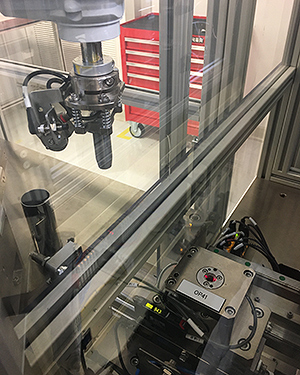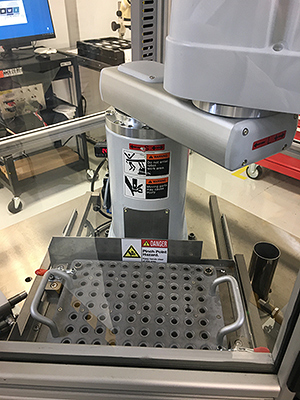 Fueled by a passion for product and customer service excellence, BWI Group (BWI) of Kettering, Ohio continues to improve production processes to meet stringent customer demands. A premier chassis supplier that designs and manufactures brake and suspension systems for the global transportation market, company leaders knew that addressing a bottleneck caused by a 90-degree corner buffer transfer in their valve assembly process was critical to smoother production and on-time delivery.
Fueled by a passion for product and customer service excellence, BWI Group (BWI) of Kettering, Ohio continues to improve production processes to meet stringent customer demands. A premier chassis supplier that designs and manufactures brake and suspension systems for the global transportation market, company leaders knew that addressing a bottleneck caused by a 90-degree corner buffer transfer in their valve assembly process was critical to smoother production and on-time delivery.
In search of a reliable method to efficiently tackle the right-angle turn between their assembly line and testing line, BWI explored several ideas for transferring small parts in this compact space. After conveyor system utilization proved to be inefficient and cumbersome, company leaders realized a more flexible, precise pick and place solution was required. Naturally, the discussion turned to robotic automation. To aid with the dilemma of choosing and integrating the best robot and peripherals for the material handling application, BWI reached out to the robotic experts at Korvis, a Burke Porter Group company.
With other Yaskawa robots already installed at the plant, it made sense for BWI to standardize operations with another robot from Yaskawa America Inc., Motoman Robotics Division (Dayton, Ohio). While a collaborative robot was considered to accommodate the tight floorspace layout, the application required no direct human interaction. After further deliberation, it was determined that installing an extremely fast and compact 4-axis SCARA (Selective Compliance Articulated Robot Arm) robot with a 6-kg payload capacity at the 90-degree corner would be ideal for reintroducing parts back into the processing line.
Solution
 The chosen robot solution featured a SCARA-style Yaskawa MYS450F robot with an end-of-arm tool (EOAT) containing a compliant vacuum pick up tool with a KEYENCE presence sensor, as well as a KEYENCE optical sensor. This EOAT ensured that the lightweight, valve part (6 mm x 12 mm x 60 mm, and approximately 100 grams each) could be accurately verified in the designated buffer tray or production pick up zone, as well as provided the consistency to pick identical parts the same way every time.
The chosen robot solution featured a SCARA-style Yaskawa MYS450F robot with an end-of-arm tool (EOAT) containing a compliant vacuum pick up tool with a KEYENCE presence sensor, as well as a KEYENCE optical sensor. This EOAT ensured that the lightweight, valve part (6 mm x 12 mm x 60 mm, and approximately 100 grams each) could be accurately verified in the designated buffer tray or production pick up zone, as well as provided the consistency to pick identical parts the same way every time.
Depending on the location of a part or the status of the production line, the MYS450F is programmed to perform specific tasks. For utmost accuracy and optimal part throughput, the various pick-and-place program points required highly precise machined tolerance positions and nest positions to allow the robot to perform the following:
-
A synchronized pick from the assembly zone, then lift and carry part to unload position
-
A synchronized place to the test zone and place part in the load position. If the test zone is not ready for part transfer, the robot places part into the open buffer tray position. If the assembly zone is down, the robot picks available parts from a 100-piece grid buffer tray (10 row x 10 column) for part placement into the test zone, as well as into the load position
-
Introduce error proofing and test master parts from designated buffer tray positions, as well as place parts into the test zone and load position
Results
Since being installed at BWI’s plant, the robotic solution has enabled a more systematic and timely process, moving parts fluidly with high-speed precision. The current system runs six days a week, twenty hours a day on the fully automated line. While BWI system operators were familiar with Yaskawa robot programming, to facilitate optimal system uptime, two workers attended Yaskawa Academy robot training at Yaskawa headquarters.
Another chief concern for BWI during the installation process was the robot’s ability to integrate well with other machinery on their production line. To better facilitate this, company leaders chose to upgrade the robot’s software to perform well in BWI’s Siemen PLC (Programmable Logic Controller) environment.
While teaching the robot to move from one zone to the next in their highly automated factory has been more difficult than expected, the innovative robot solution has provided a more reliable method of part transfer for BWI’s valve assembly line to the testing zone, alleviating the part flow bottleneck along the production line. With current productivity ranging around 80 percent, BWI anticipates higher throughout returns near 90 percent in the near future.
Full case study article modified originally featured on Assembly Magazine.